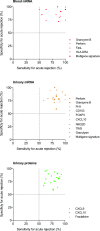Precision Transplant Medicine: Biomarkers to the Rescue
- PMID: 28993504
- PMCID: PMC5748900
- DOI: 10.1681/ASN.2017010004
Precision Transplant Medicine: Biomarkers to the Rescue
Abstract
The concept that individuals with the same disease and a similar clinical presentation may have very different outcomes and need very different therapies is not novel. With the development of many innovative tools derived from the omics technologies, transplant medicine is slowly entering the era of precision medicine. Biomarkers are the cornerstone of precision medicine, which aims to integrate biomarkers with traditional clinical information and tailor medical care to achieve the best outcome for an individual patient. Here, we discuss the basic concepts of precision medicine and biomarkers, with a specific focus on progress in renal transplantation. We delineate the different types of biomarkers and provide a general assessment of the current applications and shortcomings of previously proposed biomarkers. We also outline the potential of precision medicine in transplantation. Moving toward precision medicine in the field of transplantation will require transplant physicians to embrace the increased complexity and expanded decision algorithms and therapeutic options that are associated with improved disease nosology.
Keywords: acute rejection; chronic allograft failure; chronic graft deterioration; kidney transplantation; transplant outcomes.
Copyright © 2018 by the American Society of Nephrology.
Figures





References
-
- Hariharan S, McBride MA, Cherikh WS, Tolleris CB, Bresnahan BA, Johnson CP: Post-transplant renal function in the first year predicts long-term kidney transplant survival. Kidney Int 62: 311–318, 2002 - PubMed
-
- Naesens M, Lerut E, Emonds MP, Herelixka A, Evenepoel P, Claes K, Bammens B, Sprangers B, Meijers B, Jochmans I, Monbaliu D, Pirenne J, Kuypers DR: Proteinuria as a noninvasive marker for renal allograft histology and failure: An Observational Cohort study. J Am Soc Nephrol 27: 281–292, 2016 - PMC - PubMed
-
- Kaplan B, Schold J, Meier-Kriesche HU: Poor predictive value of serum creatinine for renal allograft loss. Am J Transplant 3: 1560–1565, 2003 - PubMed
-
- Lo DJ, Kaplan B, Kirk AD: Biomarkers for kidney transplant rejection. Nat Rev Nephrol 10: 215–225, 2014 - PubMed
Publication types
MeSH terms
Substances
LinkOut - more resources
Full Text Sources
Other Literature Sources
Medical

